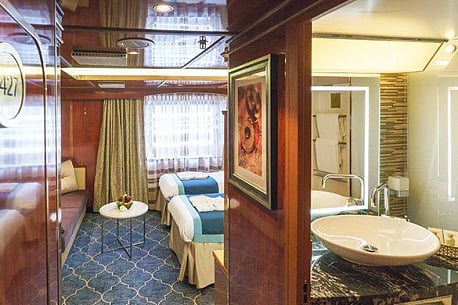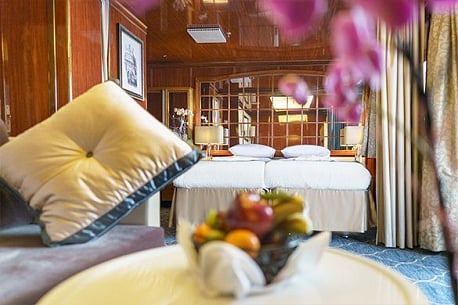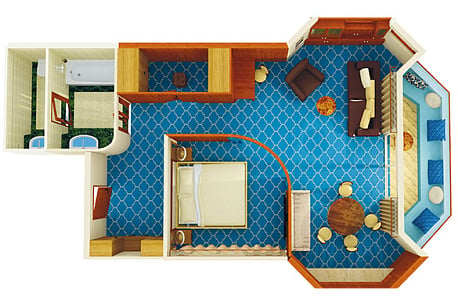
Svalbard Circumnavigation and Kvitøya
Historical Expedition Cruise "In the Footsteps of Aviation Pioneers"
GERMAN LANGUAGE ONLY
UP TO 20% OFF*
29 Jul - 11 Aug 2025
14 days
12 days


| Dates | days | Activities | Special Offers | Rates from | |
|---|---|---|---|---|---|
|
In-Depth Exploration in the Land of the Polar Bear 15 Jul - 28 Jul 2024 |
14 |


|
US$ 10 695 per person |
Request a quote | |
|
In-Depth Exploration in the Land of the Polar Bear 5 Jul - 18 Jul 2025 |
14 |


|
SUPER EARLY BIRD SAVINGS |
US$ 10 495
US$ 8 921 per person |
Request a quote |
|
In-Depth Exploration in the Land of the Polar Bear 17 Jul - 30 Jul 2025 |
14 |


|
SUPER EARLY BIRD SAVINGS |
US$ 10 495
US$ 8 921 per person |
Request a quote |
VIDEO
Itinerary

Your Arctic adventure begins today as you follow in the footsteps of North Pole explorers!
Welcome to Longyearbyen, the administrative center of Svalbard and the starting point of our Arctic expedition.
Upon arrival at Longyearbyen airport, our German-speaking staff will warmly welcome you and facilitate your transfer to a comfortable hotel, which we have arranged and included in the itinerary's price. Feel free to explore the charming and walkable town center at your leisure.
We recommend commencing your exploration of this captivating Norwegian High Arctic territory at the impressive Svalbard Museum, where you can also acquire rare polar books and maps. Later, indulge in an outstanding dinner at one of Longyearbyen's delightful restaurants.
As evening falls, experience the mesmerizing effect of the midnight sun, with daylight persisting throughout your stay in Svalbard. Weather permitting, bask in the sunshine late into the night before retiring to bed. Close the curtains, get a good night's sleep, and prepare for embarkation and the commencement of your expedition the following day

The day begins with a delightful breakfast at the hotel. As your luggage is transported to the ship in the morning, enjoy an exciting city tour exploring the history and culture of the northernmost city in the world.
The tour concludes with a visit to the North Pole Expedition Museum, where you can refresh your knowledge of the often perilous North Pole expeditions and get a taste of the historical locations you'll experience during our cruise.
Following this, you'll have some free time, perhaps for lunch in one of the many cafes and restaurants in Longyearbyen or an opportunity for souvenirs or last-minute shopping. Keep in mind that you'll soon receive your own parka, which you can keep, and waterproof boots to borrow on board the ship.
Then, it's time to board! Not on an airship or hydroplane like Amundsen or others, but on our comfortable expedition ship, MV Sea Spirit, awaiting us at the port of Longyearbyen. We'll take you to the pier where you'll be welcomed on board. Settle into your spacious suite and explore the ship, your comfortable home for the extraordinary adventure ahead.
Once on board, a full program of briefings and lectures from your expedition team will begin. After the first of many delightful dinners on board, head to the open decks and admire the magnificent scenery in 24 hours of daylight.

.jpg)


.jpg)
On this trip, our goal is to circumnavigate the Svalbard archipelago, and weather and ice conditions permitting, we'll attempt to reach the white island, Kvitøya, the last resting place of the Andrée expedition in the far northeast of Svalbard. Unless a polar bear pays a visit to the monument of the polar explorers, we can anticipate a landing at Andreeneset.
Throughout the journey, we aim to immerse ourselves in the many facets of this incredible High Arctic territory. Much of Spitsbergen's pristine nature is safeguarded by a system of national parks, with the Northwest Spitsbergen National Park being the first along our route. It stands as the crown jewel of Svalbard's scenic wonders, known for deep fjords flanked by serrated mountain ranges and immense tidewater glaciers, calving icebergs into turquoise waters. The skies come alive with millions of murres, guillemots, and little auks, whose eggs are currently hatching at numerous breeding colonies on small islands, mountainsides, and sea cliffs within the park. This presents a wonderful opportunity to encounter marine mammals, including beluga whales and various Arctic seals.
Enchanting places dot this beautiful area, such as the Blomstrand Peninsula and the Kongsbreen Glacier ("King's Glacier"). Human settlement, though rare along our route, can be found in Ny Ålesund—a former mining town and airship base that is now home to an international community of Arctic explorers. As one of the northernmost settlements globally, Ny Ålesund houses a museum, a souvenir shop, and a post office. It's also the starting point for the famous expeditions of the airships Norge and Italia led by Roald Amundsen and Umberto Nobile to the North Pole. The anchor mast of the airships still stands tall just behind Ny-Ålesund.

Further north, the small bay of Virgohamna served as the starting point for another spectacular expedition. In 1896/97, Salomon August Andrée aimed to be the first person to fly over the North Pole and crafted a hydrogen-fueled balloon. Taking off northwards from Virgohamna Bay, unlike Nobile and Amundsen, he wasn't fortunate enough to reach the Pole. Walter Wellman also commenced his unsuccessful attempts to fly to the North Pole from this very location.
The Svalbard archipelago sits halfway between the northern part of Norway and the North Pole. Depending on the season, weather, and ocean currents, we anticipate encountering pack ice in the north of Svalbard. Our plan is to journey along the ice edge towards the island of Nordaustlandet and further east towards Kvitøya. However, please bear in mind that our route is highly contingent on the weather and the current ice situation.

.jpg)
On this part of the journey we will try to reach the eastern and northern regions of the Svalbard archipelago, which are rarely visited by expedition ships. Here we will experience the true isolation and remoteness and the beautiful solitude of the Arctic wilderness.
Kvitøya is one of the rarely visited islands closest to Franz Josef Land. This place, which is almost completely covered by ice, was the final resting place of the balloon expedition of the Swedish polar explorer Salomon August Andrée.
Kvitøya is not always accessible to expedition ships, but may offer another opportunity to observe polar bears in their natural habitat.

.jpg)
.jpg)

During this trip we are likely to encounter significant amounts of sea ice in the vast Northeast Svalbard Nature Reserve and around Nordaustlandet, Svalbard's second largest island.
In this remote and unique region, the ice may persist well into the summer. The massive ice cap of Austfonna rises above the breathtaking landscapes of the High Arctic. Part of it meets the sea along the 45-kilometer-long Bråsvellbreen ice cliff - one of the greatest wonders of the Arctic world.
The polar desert landscape of Nordaustlandet, on the other hand, offers little vegetation but is home to a large number of seabirds. The cliffs of Alkefjellet are home to thousands of guillemots, glaucous gulls and other seabirds. In the past, this impressive rock formation has not only been a great spot for birdwatching, but has also repeatedly provided opportunities to spot foxes.
Although we are now leaving the paths of Amundsen, Nobile and Andrée, we can still listen to the fascinating lectures and watch historical film footage.


.jpg)
.jpg)
The Southeast Svalbard Nature Reserve is a truly pristine and rarely visited wilderness containing hundreds of uninhabited islands. On the large islands of Edgeøya and Barentsøya, broad tundra valleys support the territory’s densest population of endemic Svalbard reindeer.
The valleys are also important breeding areas for ground-nesting birds such as geese, eiders and sandpipers. Arctic foxes prowl the vast landscape, seeking to provide food for their young cubs, who are just now emerging from their dens. Shallow, murky seas are ideal feeding grounds for walruses resting in large numbers on gently sloping beaches. Historical sites throughout the islands provide glimpses into the region’s bygone era of trapping and hunting.
South Spitsbergen National Park is a vast region of varied landscapes, including polar deserts and impassable mountain ranges. The centerpiece of this park is Hornsund, a picture-perfect fjord where countless mighty glaciers cascade from soaring mountaintops into icy inlets. The park also includes the southern shores of Bellsund, a picturesque bay where the remains of historical whaling operations can be found, including wooden boats, cabins and thousands of whale bones — a scene from the distant past, literally frozen in time. Throughout the park, there is always a high probability of wildlife sightings. Wildflowers will be at their peak during this time.
Given its length and theme, this ambitious and in-depth historical expedition cruise around Svalbard offers a fantastic opportunity to delve into the history of aviation pioneers up close and learn about the many facets of the Arctic.
Every day offers something new and exciting. We will not miss a single opportunity to encounter the fascinating wildlife of the Arctic, experience incredible polar landscapes and follow in the footsteps of historic expeditions.

Our circumnavigation of the archipelago is coming to an end. We are back in the Isfjord on the west coast of Svalbard. Here we also get to experience beautiful places such as Alkhornet and Skansbukta before we return to Longyearbyen.
Onboard, we reflect on the journey, recalling the adventures of the aviation pioneers and historical locations we visited in the last few days.

After filling up with one last buffet breakfast on board, we bid you farewell in Longyearbyen.
We offer transfers to the airport or the city center if you wish to stay longer in Svalbard.
Perhaps you are already making plans for your next fantastic journey with us to the polar worlds!
Itinerary, landings and all other activities during the cruise depend strongly on ice and weather conditions and are subject to the decisions of the Expedition Leader and the Captain of the vessel. Encounters with any mentioned wildlife cannot be guaranteed.
Rates
| Triple Suite |
US$ 9 006
US$ 10 595 |
request Book online | ||||||||||




|
||||||||||||
| Main Deck Suite |
US$ 12 406
US$ 14 595 |
request Book online | ||||||||||




|
||||||||||||
| Single Suite |
US$ 18 441
US$ 21 695 |
request Book online | ||||||||||






|
||||||||||||
| Classic Suite |
US$ 13 171
US$ 15 495 |
request Book online | ||||||||||





|
||||||||||||
| Superior Suite |
US$ 12 636
US$ 15 795 |
request Book online | ||||||||||




|
||||||||||||
| Deluxe Suite |
US$ 14 236
US$ 17 795 |
request Book online | ||||||||||




|
||||||||||||
| Premium Suite |
US$ 15 516
US$ 19 395 |
request Book online | ||||||||||





|
||||||||||||
| Owners Suite |
US$ 19 916
US$ 24 895 |
request Book online | ||||||||||






|
||||||||||||
* Super Early Bird discount (15% off on Triple, Main Deck, Single, and Classic Suites; 20% off on Superior, Deluxe, Premium, and Owner’s Suites) is available for new bookings confirmed by June 30, 2024.
Cruise rates are quoted per person. Sharing is available in Triple, Main Deck, Classic, and Superior Suites. If you prefer a cabin for yourself, the following categories are available with the single supplement: x1.7 for Main Deck, Classic, and Superior Suites; x2 for Deluxe, Premium, and Owner's Suite.
Rates Include:
- 1 pre-voyage night on Day 1 in a hotel in Longyearbyen;
- Group transfer to the ship for embarkation on Day 2;
- Guided city tour (day 2);
- Entry and guided tour through Northpole Expedition Museum (day 2);
- Group transfer upon disembarkation;
- Shipboard accommodation;
- Group transfer from the airport to the hotel on Day 1;
- All meals on board throughout the voyage;
- AECO fees and governmental taxes.
- Tea and coffee station 24 hours daily;
- All scheduled landings/excursions (subject to weather and ice conditions);
- Leadership throughout the voyage by our experienced Expedition Leader & Expedition Team;
- Branded Poseidon Expeditions parka;
- Rubber boots for shore landings for the time of the cruise;
- Welcome and Farewell cocktails;
- All port fees;
- Pre-departure materials;
- Digital Voyage Log;
- Wi-Fi on board.
Rates Do Not Include:
- Airfare;
- Visa and passport fees (if applicable);
- Fuel surcharge may be applied for all bookings;
- Luggage and trip cancellation insurance;
- Soft drinks and alcoholic beverages other than those for special events and celebrations;
- Personal expenses such as laundry and telecommunication charges;
- Mandatory Emergency Evacuation Insurance to a minimum benefit of US$ 200,000 per person;
- Kayaking;
- Staff gratuities.
Expedition Leader

Christian Bruttel
Growing up in the cosy town of Villingen in the Black Forest, Christian discovered his passion for foreign cultures and faraway countries both before and during his studies to become a teacher. He took every opportunity to explore the world on various trips. And so he followed a long-growing fascination for the Arctic to Svalbard.
He completed his studies to become an Arctic Nature Guide in 2013. Since then, he has lived in Longyearbyen and worked as a guide throughout Svalbard. He finds his greatest joy in introducing people to the Arctic nature and its impressive landscapes. He introduces people to the beauty and fragility of the Arctic ecosystem and is happy to share his experiences with enthusiastic guests.
Adventure options

Kayaking fee $795 - €695 - A$1200 - £650
Sea Kayaking is typically offered on voyages that include High Arctic destinations such as Greenland, Svalbard (Spitsbergen), Franz Josef Land, or a combination of these thrilling places. Experience calving glaciers in Svalbard, cathedral-like icebergs in Greenland, or labyrinthine expanses of sea ice in the Arctic Ocean, all from our sturdy and stealthy sea kayaks. Join us for an unscripted kayaking adventure as we explore rugged coastlines and remote waters that very few people have ever paddled.

Free option
The Polar Regions are perhaps the most photogenic on earth, with countless beautiful scenes presenting themselves every day. Endless expanses of ice, beaches crowded with seals or penguins, sunsets over unbroken horizons, starlit skies, and even the majestic northern lights – they all present fantastic photographic opportunities – and in order to make sure that you come home with some spectacular images we offer you the chance to learn and practice your photography alongside an experienced professional.
Our expert Photographer will be on hand to answer your questions and give advice, both in the form of on-board lectures and workshops on shore. Explore the key elements of photography in a fun and relaxed setting, with plenty of opportunities for questions and feedback. Learn how to see light in a new way and experiment with the techniques of composition and framing.
request a quote
Cabin:
Date:
Duration:
Articles

Pomors – Pioneers of Arctic Exploration
Nowadays people travel in the Arctic aboard massive icebreakers with reinforced hulls. But it wasn’t...

Growing threat for polar bears
Polar bears are, at least in their image in the popular imagination, among the cutest, cuddliest...

Global warming: for good or ill
The concept of global warming, or climate change, has become a point of contention among scientists,...

Did you know that…?
The area of the Arctic is almost 3 times the size of Europe and is about 27 million km². For a long...









